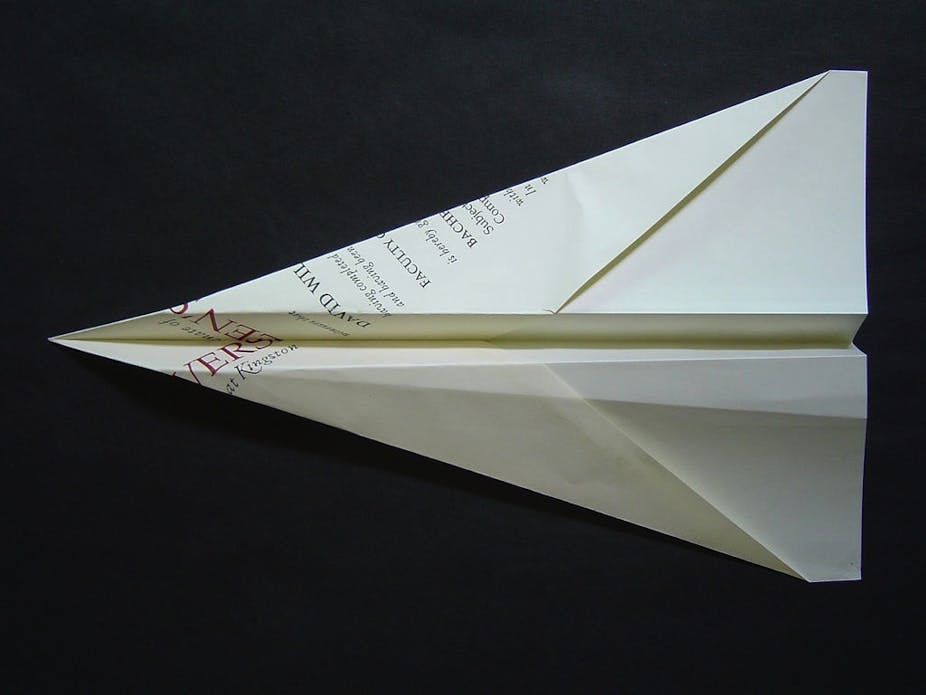Late last week the Defence Advanced Research Programs Agency (DARPA) in the USA launched a second flight of a craft called the HTV-2, designed to glide at Mach 20 while re-entering the earth’s atmosphere.
Let’s put Mach 20 into some kind of context. Modern commercial airliners cruise at around 800km/h – roughly Mach 0.8.
Mach 1 – the speed of sound – is a little more than 1000km/h. Aircraft that can travel at greater than Mach 5 (~5000 km/hr) are known as “hypersonic”.
The HTV-2 glides at Mach 20 (~20,000km/h) – an incredibly high speed to travel within the Earth’s atmosphere. If you could sustain this speed for long enough you could go from Sydney to London in around 50 minutes.
But travel at these speeds is not new. Ever since the dawn of the space age astronauts have been propelled to considerably faster speeds in order to enter earth orbit.
What’s different about the HTV-2 is that it “flies” at these speeds within Earth’s atmosphere. At altitudes below about 50 kilometres this generates incredible friction.
The heat from atmospheric friction can lead to the melting of all known materials if the heat cannot be dissipated.
Conventional aluminium can be used for aircraft such as the now-retired Concorde that fly at speeds below Mach 2. The American SR-71 Blackbird, which flew at speeds greater than Mach 3, was made of titanium, an extremely light and strong metal that can maintain its strength up to 450 degrees Celsius.
Heating rates from flight through the atmosphere increase as the [“cube”](http://en.wikipedia.org/wiki/Cube_(algebra) of the Mach number.
Consequently, the HTV-2 encountered heating rates that were almost 300 times greater than the SR-71 when flying at the same altitude. To survive such temperatures, the HTV-2 uses a type of material known as Ceramic Matrix Composites (CMC) that can maintain their strength up to 2,000 degrees Celsius or more.
Reports indicate the HTV-2 did not complete its flight as planned.
There are many things that can go wrong on an experimental flight like this. At this stage it’s not known if the incredibly high heating of the HTV-2’s outer skin was to blame for the failure, or if something else was at play.
While the goals of the HTV-2 are impressive, the craft is a simple glider with no propulsion system. Its range is therefore limited by aerodynamic efficiency, in particular its lift to drag ratio.
The real future of hypersonic flight in the atmosphere is the design of hypersonic air-breathing engines called Supersonic Combustion Ramjets (Scramjets).
Australia is at the forefront of scramjet technology through the research and flight testing being done within the Centre for Hypersonics at the University of Queensland.

Scramjets work in the same way as a conventional jet engine, by increasing the velocity (and therefore momentum) of air passing through it by burning fuel.
As you might remember from high school science lessons, Sir Issac Newton showed that a change in momentum produces a force. In an air-breathing engine the change in momentum of the air creates thrust.
At hypersonic speed the engine thrust must overcome the drag generated by pushing the air out of the way at tremendous speeds. In this way, scramjets are fighting an uphill battle.
Current research, authored by myself and others, shows scramjets may be able to operate up to Mach 12 or even Mach 14.
If this can be proved in flight, then travel around the globe in a matter of hours is possible. Scramjets can also be used to put satellites into space more efficiently than rockets.
The same high temperature materials pioneered for use in the HTV-2 are expected to be applied to hypersonic vehicles propelled by scramjets.
While aircraft such as the HTV-2 or those being developed at UQ are still in the experimental phase, the ultimate goal is to see hypersonic aircraft enter the commercial market.
The first experience that you or I might have of hypersonic flight could come as an extension of the space adventure flights to be offered by Virgin Galactic.
Watch this space.

